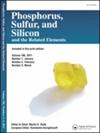Bis(2-furanylmethyl)monospiro(N/N)cyclotriphosphazenes: synthesis, structural characterization, antiproliferative, and antimigratory activity studies
IF 1.4
4区 化学
Q4 CHEMISTRY, INORGANIC & NUCLEAR
Phosphorus, Sulfur, and Silicon and the Related Elements
Pub Date : 2023-12-02
DOI:10.1080/10426507.2023.2242995
引用次数: 0
Abstract
In this study, the condensation reaction of hexachlorocyclotriphosphazene, N3P3Cl6 (HCCP) with N 1,N3-bis(furan-2-ylmethyl)-1,3-diamino-propane (1) yielded tetrachlorobis(2-furanyl-methyl)monospiro(N/N)cyclotriphosphazene (2). Fully substituted tetraaminobis(2-furanylmethyl)-spiro(N/N)cyclotriphosphazenes (2a and 2b) were obtained by Cl replacement reactions with excess pyrrolidine and piperidine, respectively, using dry THF under reflux of 2. The structures of the phosphazenes were confirmed by data obtained by elemental analysis, FT-IR, ESI-MS, 1H, 13C, and 31P NMR. Moreover, the molecular structure of 2b was elucidated by X-ray crystallography. The antiproliferative effects of phosphazenes (2, 2a, and 2b) on prostate (PC-3) and colon cancer (HT-29) cell lines were determined by cell viability analysis using MTT assay. Antimigratory effects were also investigated by scratch analysis. In addition, the effects of compounds against genes involved in apoptosis and cell migration were evaluated by gene expression analysis. As a result, it was found that compound 2a was more effective than compound 2b in both prostate and colon cancer cell lines.
双(2-呋喃基甲基)单螺(N/N)环三磷腈:合成、结构表征、抗增殖和抗迁移活性研究
本文章由计算机程序翻译,如有差异,请以英文原文为准。
求助全文
约1分钟内获得全文
求助全文
来源期刊
CiteScore
2.60
自引率
7.70%
发文量
103
审稿时长
2.1 months
期刊介绍:
Phosphorus, Sulfur, and Silicon and the Related Elements is a monthly publication intended to disseminate current trends and novel methods to those working in the broad and interdisciplinary field of heteroatom chemistry.

 求助内容:
求助内容: 应助结果提醒方式:
应助结果提醒方式:


